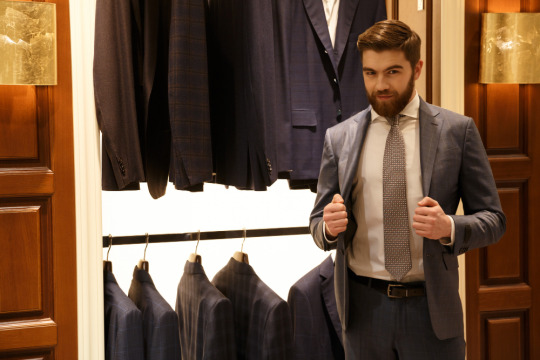Don't wanna be here? Send us removal request.
Text
From Fabric to Fit: The Journey of Bespoke Suits

In a world where mass production and fast fashion dominate, the bespoke suit stands as a beacon of craftsmanship, individuality, and timeless elegance. This article takes you through the intricate journey of a bespoke suit, from the initial selection of fabric to the final fitting. We will explore the meticulous process, the skilled artisans behind it, and the lasting allure of bespoke tailoring.
The Origins of Bespoke Tailoring
Bespoke tailoring has a rich history that dates back to the 17th century in London's Savile Row. This iconic street became synonymous with high-quality, custom-made suits. The term "bespoke" itself is derived from the verb "to bespeak," meaning to order or arrange in advance. Bespoke tailoring was, and still is, about creating garments specifically for an individual, considering their unique measurements, preferences, and style.
Selecting the Fabric: The Foundation of a Bespoke Suit
The journey of a bespoke suit begins with the selection of fabric. This step is crucial as the fabric sets the tone for the entire garment. Clients are presented with a wide array of materials, each with its own characteristics. Wool, the most traditional choice, offers durability and versatility. Cotton, linen, and silk are also popular, each providing a distinct look and feel.
When choosing fabric, considerations include the suit's intended use, the season, and the client's personal style. For example, a heavier wool might be selected for a winter suit, while a lighter linen could be perfect for summer. The weight, weave, and color of the fabric all play a role in the final appearance and functionality of the suit.
The Initial Consultation: Crafting a Vision
Once the fabric is chosen, the next step is the initial consultation with the tailor. This meeting is essential as it allows the tailor to understand the client's vision and requirements. It's a collaborative process where the client's preferences for style, fit, and details are discussed in depth.
During this consultation, the tailor takes precise measurements of the client's body. These measurements go beyond the standard chest, waist, and hip sizes. The tailor notes posture, shoulder slope, arm length, and other unique body characteristics. This meticulous attention to detail ensures that the final garment will fit the client perfectly.
The Pattern Drafting: Turning Vision into Blueprint
With measurements in hand, the tailor begins the process of pattern drafting. Unlike ready-to-wear suits, where patterns are standardized, bespoke patterns are created from scratch for each individual client. This step is akin to creating a blueprint for a building.
The tailor draws the pattern on paper, considering the client's measurements and desired style. Each piece of the suit, from the jacket to the trousers, is carefully planned out. This custom pattern ensures that every aspect of the suit will conform to the client's body, providing a fit that is both comfortable and flattering.
Cutting the Fabric: Precision and Expertise
Once the pattern is complete, it's time to cut the fabric. This step requires precision and expertise, as any mistakes can result in wasted material. The tailor carefully lays the pattern pieces onto the fabric, aligning them to ensure that the fabric's grain and pattern match perfectly.
Cutting the fabric is a skill that takes years to master. The tailor uses sharp shears to cut along the pattern lines, ensuring clean and accurate edges. This step sets the stage for the construction of the suit, as each piece of fabric will soon come together to form a cohesive garment.
Basting: The First Fitting
With the fabric pieces cut, the next step is basting. Basting involves temporarily stitching the pieces together to create a rough version of the suit. This allows the tailor and client to conduct the first fitting and make necessary adjustments.
During the fitting, the client tries on the basted suit. This is a crucial moment in the bespoke process, as it allows the tailor to see how the suit fits on the client's body and identify any areas that need refinement. Adjustments are made to ensure that the suit aligns perfectly with the client's proportions and preferences.
Constructing the Suit: The Art of Tailoring
After the initial fitting and adjustments, the tailor begins the construction of the suit. This involves sewing the fabric pieces together with precision and care. The suit's canvas, which is the inner structure, is also constructed during this phase. The canvas gives the suit its shape and support, ensuring that it drapes elegantly on the body.

The jacket, trousers, and waistcoat (if included) are meticulously assembled. The tailor pays close attention to details such as lapels, pockets, and buttonholes. Hand-stitching is often used for these elements, adding to the suit's durability and aesthetic appeal.
The Second Fitting: Fine-Tuning the Fit
Once the suit is constructed, the second fitting takes place. This fitting is an opportunity to fine-tune the fit and make any final adjustments. The tailor examines the suit on the client, ensuring that it conforms to their body perfectly. Adjustments may be made to the jacket's shoulders, the length of the trousers, and other areas to achieve the desired fit.
The second fitting is a testament to the bespoke process's commitment to perfection. Every detail is scrutinized to ensure that the suit not only fits well but also enhances the client's appearance and confidence.
Finishing Touches: The Details That Matter
With the fit perfected, the final step is adding the finishing touches. This includes sewing on buttons, hemming the trousers, and pressing the suit to give it a polished look. These details may seem minor, but they contribute significantly to the overall quality and appearance of the suit.
Button selection is an important aspect of this phase. Clients can choose from a variety of buttons, including horn, mother-of-pearl, and metal. The tailor also ensures that the buttonholes are meticulously crafted, often using hand-stitching for added durability and elegance.
The Final Fitting: A Perfectly Tailored Suit
The journey of a bespoke suit culminates in the final fitting. During this fitting, the client tries on the fully constructed suit for the first time. The tailor makes any last-minute adjustments to ensure that the suit fits flawlessly. This moment is a celebration of the craftsmanship, dedication, and collaboration that went into creating the garment.
A perfectly tailored bespoke suit not only fits the client's body but also reflects their personality and style. It is a garment that exudes confidence and sophistication, setting the wearer apart from the crowd.
The Artisans Behind the Suit: Tailors and Their Craft
The creation of a bespoke suit is a testament to the skill and artistry of the tailor. These artisans dedicate years to mastering their craft, combining traditional techniques with modern innovations. The tailor's role goes beyond mere construction; they are artists who bring a client's vision to life.
Tailoring is a profession steeped in tradition, passed down through generations. Many bespoke tailors apprentice under experienced masters, learning the nuances of the trade. This dedication to learning and preserving the craft ensures that bespoke tailoring remains a revered art form.
The Timeless Appeal of Bespoke Suits
In an era dominated by fast fashion, the bespoke suit stands as a symbol of timeless elegance and individuality. Unlike mass-produced garments, which often prioritize trends over quality, bespoke suits are designed to last. They are investment pieces that can be worn for years, adapting to the wearer's evolving style.
The allure of bespoke suits lies in their ability to make a statement. A bespoke suit is not just clothing; it is a reflection of the wearer's personality, taste, and appreciation for craftsmanship. Whether worn for a special occasion or as part of everyday attire, a bespoke suit elevates the wearer's presence and leaves a lasting impression.

Conclusion
The journey of a bespoke suit is a meticulous and rewarding process that combines artistry, craftsmanship, and individuality. From the careful selection of fabric to the final fitting, every step is a testament to the dedication and skill of the tailor. A bespoke suit is more than just a garment; it is a masterpiece that tells a story of tradition, excellence, and personal style.
In a world where fashion often prioritizes speed and convenience, the bespoke suit reminds us of the value of patience, precision, and artistry. It is a celebration of the human touch in an increasingly mechanized industry. As long as there are those who appreciate quality and individuality, the bespoke suit will continue to thrive, standing as a timeless symbol of sartorial excellence.
1 note
·
View note